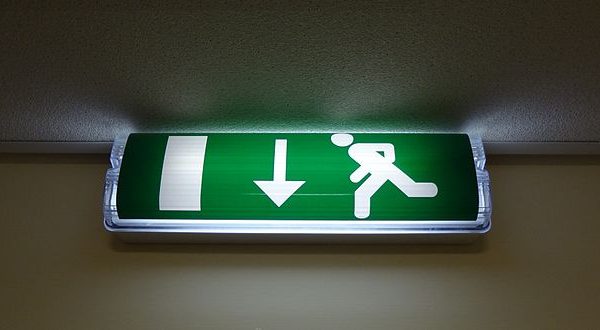
Emergency exit lighting devices are self-contained battery-powered lighted boxes that indicate exits. They help guide building occupants to the exit during an emergency. Emergency exit lighting must be illuminated at all times while the building is open and have backup power when the main AC power has been disrupted.
Emergency lighting is another life safety system that automatically turns on during an AC power failure, but they illuminate spaces instead of just the sign itself. They must provide sufficient lumination for a long enough period of time to allow the building occupants to finish any potentially dangerous task and exit the building safely.
Emergency exit lighting is one of the cornerstones of life safety. It provides illumination not just during a possible electrical failure from a fire but also when the building loses its primary electrical supply due to bad weather or other maintenance issues. Even longtime employees or residents can become disoriented during an emergency, and emergency exit lights and emergency lighting can make the difference between life and death.
Ontario Fire Code
Several sections of the Ontario Fire Code refer to the requirements of commercial buildings that need to have emergency and exit lighting. Four of the most important ones are included below.
1) Visibility
Exit signs must be clean, legible, and clearly visible. They can be illuminated either externally or internally according to the sign’s design while the building is occupied. Exit signs with self-luminous material must be maintained according to the manufacturer’s instructions and any conditions specified under the Building Code.
2) Testing
This section spells out the requirements necessary for the testing of emergency lighting. You must test the pilot lights monthly for operation and inspect the following:
- Ensure the terminal connections are clean, corrosion-free, lubricated (if necessary), and tight according to the manufacturer’s recommendations.
- Batteries are clean and dry
- Battery electrolyte levels and specific gravity meet the manufacturer’s specifications
You must also test emergency lighting according to the schedule:
- Monthly. The lights turn on when you cut the main AC power.
- Annually. The lights remain illuminated for the time specified by the system design.
Once the lights have stayed on for the required time limit, you must also test them to make sure the battery’s recovery period is within the manufacturer’s recommendations.
3) Meet Building Codes
Section 9.2.3 states that emergency lighting must adhere to article 3.2.7.3. of the 1986 Building Code and the marking signs for exits and exit access must comply with 3.4.5. of the 1986 Building Code.
4) Section 9.5.3.9
You must install emergency exit lighting in exit stairways, public corridors, or any exit access in buildings with an occupancy load above 24 or have more than 10 dwelling units. This lighting must meet the standards below:
- The lights should stay on for at least 30 minutes.
- They must have a backup power source separate from the main building’s electrical supply.
- The lights should turn on as soon as the main power source has been interrupted.
- The lights should provide an average illumination of at least 10 lx at the floor or tread level.
These are just some of the many requirements dictated by the Ontario Fire Code. You can check to see if your emergency and exit lighting is up to code yourself, or you can consult the experts at All Protect Systems.
They have been installing and servicing emergency and exit lighting for Ontario area businesses since 1996. They also service fire alarm systems, fire hoses, gas detection, and even design fire safety plans. Call them today to find out what they can do for you!